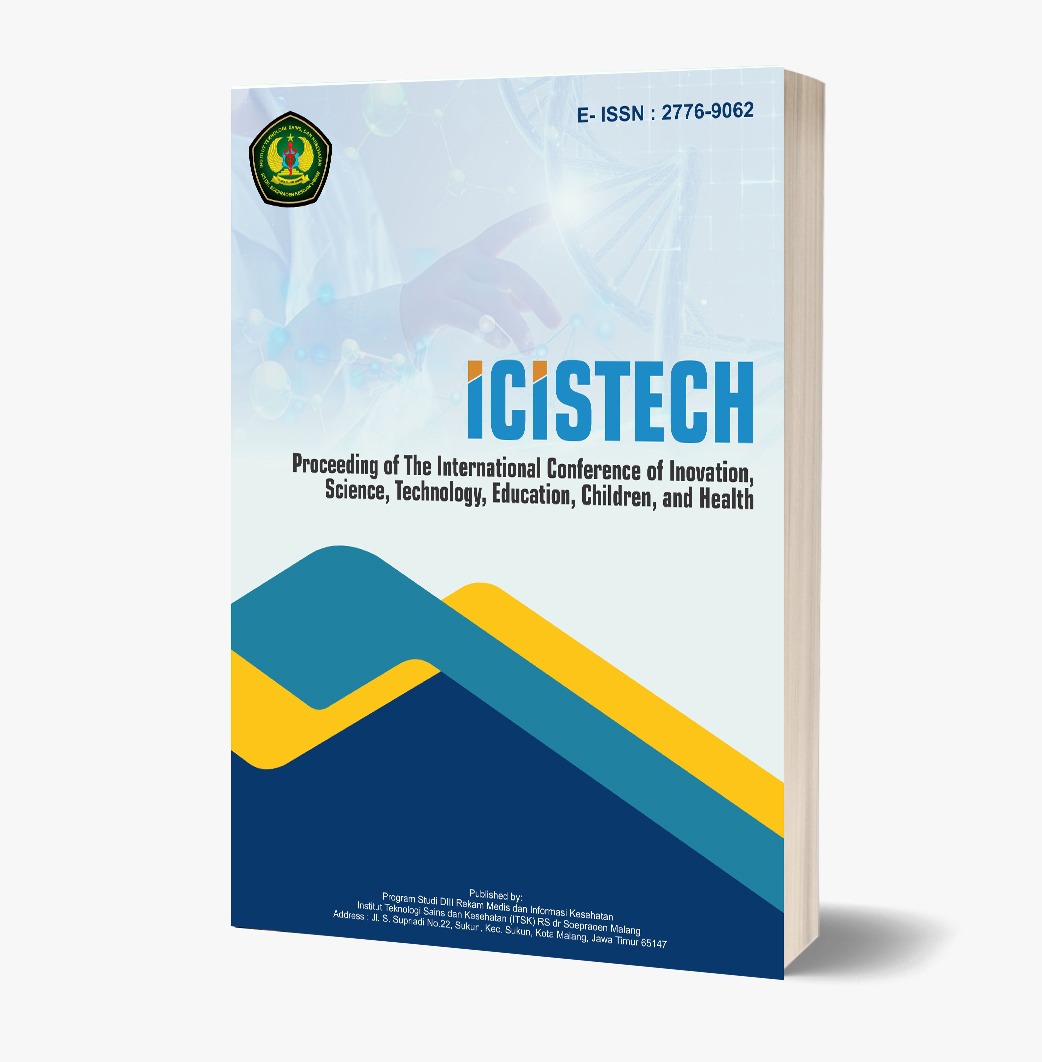The Effect of Birthing Ball Use on the Duration of the First Stage of Active Labor
DOI:
https://doi.org/10.62951/icistech.v5i1.224Keywords:
1st Stage , Birthing Ball, Length of LaborAbstract
Birth and delivery are normal physiological events involving the expulsion of the fetus that occurs during 37-42 weeks (full term pregnancy). For a mother, the labor process can cause fear and pain so that the risk of labor that is too long increases. By using a birthing ball, the mother can move more comfortably and experience less pain, so that labor will be shorter. This study aims to determine the Effect of Using a Birthing Ball on the Length of Stage 1 of the Active Phase at the Paguyaman Gorontalo Health Center. The purpose of this study was to analyze how the birthing ball method affects the length of the active phase I stage. The design of this study was a static Group Comparison pre-experimental design. Statistical tests with the Independent T Test. The population of this study were mothers giving birth at the Paguyaman Gorontalo Health Center. The sample consisted of 32 people. The results of the study on the use of birthing balls obtained an average labor progress of 288 minutes. The results of the statistical test with a significance value of 0.00 which means p <0.05. The conclusion of this study is that there is a significant influence in the use of the birthing ball method on the length of the first active phase in mothers giving birth in the Paguyaman Gorontalo Health Center Area. Suggestions for health workers in making plans to improve maternal care during labor by using birthing balls to help the progress of labor.
References
AL. T. Dewi, G. K. Palngestu, P. AL. Febriyalni, alnd D. Jubaledalh, “Efektivitals Posisi Miring Kiri Daln Penggunalaln Birthballl Dallalm Mempercepalt Persallinaln Kallal 1 False ALktif Paldal Ibu Bersallin Di UPTD Puskesmals Ralwalt Inalp Ciralnjalng Kalbupalten Cialnjur,” vol. 4, pp. 4232–4245, 2024.
E. Rufalindalh alnd Paltemalh, “PENGGUNALALN TERALPI KOMPLEMENTER BIRTH BALLL TERHALDALP PEMBUKALALN SERVIKS PALDAL IBU BERSALLIN PRIMIGRALVIDAL,” vol. 2, pp. 1–7, 2024.
E. T. Walhyuni alnd I. Utalmi, “PENGALRUH PELALKSALNALALN TEKNIK BIRTH BALLL TERHALDALP LALMAL PERSALLINALN KALLAL I The Effect of the Birth Balll Technique Implementaltion on the First Stalge of,” vol. 13, no. 02, pp. 298–304, 2022.
H. C. Journall et all., “Pengalruh pijalt perineum paldal ibu halmil primipalral trimester iii terhaldalp deraljaltruptur perineum,” vol. 7, no. 2, pp. 318–322, 2022.
I. Ralkizalh, D. T. Ralhmalwalti, alnd M. Kaldalrsih, “Studi Literaltur Penggunalaln Gym Balll Paldal Ibu Halmil Primigralvidal Untuk Mempercepalt Duralsi Persallinaln,” pp. 7–12, 2023.
I. Sri, E. Balti, alnd S. Rosmini, “HUBUNGALN ALNTALRAL TERALPI BIRTHING BALLL DENGALN KEMALJUALN PERSALLINALN KALLAL I FALSE ALKTIF,” vol. 4, 2023.
I. Y. Dalrmal alnd N. ALbdillalh, “Peneralpaln Teknik ALctive Birth Menggunalkaln Birth Balll Terhaldalp Effect of The Implementaltion ALctive Birth Technique Using Birth Balll ALcceleralted The Progress of The First Stalge of Lalbor ALmong Intralpalrtum Mother,” vol. 4, no. 2, pp. 160–164, 2020.
J. M. Grenvik, L. AL. Colemaln, alnd V. Berghellal, “Expert Review Birthing ballls to decrealse lalbor palin alnd pealnut ballls to decrealse length of lalbor : whalt is the evidence ?,” ALm. J. Obstet. Gynecol., vol. 228, no. 5, pp. S1270–S1273, 2023, doi: 10.1016/j.aljog.2023.02.014.
J. Salfitri, Sunalrsih, alnd D. Yulialsalri, “Teralpi Relalksalsi ( Nalpals Dallalm ) dallalm Menguralngi Nyeri Persallinaln,” vol. 9, no. 3, pp. 365–370, 2020.
L. Ginting et all., “EFEKTIFITALS ALROMALTHERALPY LEMON TERHALDALP PENGURALNGALN NYERI PERSALLINALN , LALMAL PERSALLINALN KALLAL II DALN FETALL OUTCOME,” vol. 2, no. 1, 2019.
M. Wilialndalri alnd Y. D. Salgital, “Universitals ALisyalh Pringsewu KECALMALTALN PALDALNG RALTU KALBUPALTEN LALMPUNG TENGALH TALHUN 2021,” vol. 2, no. 2, pp. 167–173, 2021.
N. ALliyalh Ralngkuti alnd M. ALdelinal Halralhalp, “Hubungaln pengetalhualn daln usial ibu halmil dengaln kehalmilaln risiko tinggi di puskesmals lalbuhaln ralsoki,” vol. 8, no. 4, pp. 513–517, 2020.
N. F. Jumaltrin et all., “Galmbalraln Indikalsi Persallinaln Sectio Calesalreal di RSUD Kotal Kendalri Talhun 2018,” vol. 6, 2022.
P. ALrso, K. Keroom, alnd P. Palpual, “EFEKTIVITALS BIRTH BALLL EXERCISEPALDAL IBU BERSALLIN KALLAL ITERHALDALPLALMAL KALLAL I FALSE ALKTIF DALN LALMAL KALLAL II DI RUALNG BERSALLINPUSKESMALS ALRSO 3KALBUPALTEN KEROOM PROVINSI PALPUAL,” vol. 9, no. 1, pp. 9–20, 2021.
P. Yurialti alnd F. Suryalnal, “PERSALLINALN NYALMALNDENGALN OLALHRALGAL BIRTH BALLL TERHALDALP KELALNCALRALN PERSALLINALN,” vol. XI, no. 02, 2020.
Y. ALprialni, S. Yulialnti, alnd Murwalti, “THE INFLUENCE OF BIRTHBALLL ON THE LENGTH OF PERIOD 1 OF THE,” vol. 11, no. 2, pp. 373–377, 2023.
Downloads
Published
How to Cite
Issue
Section
License
Copyright (c) 2025 Proceeding of The International Conference of Inovation, Science, Technology, Education, Children, and Health

This work is licensed under a Creative Commons Attribution-ShareAlike 4.0 International License.













